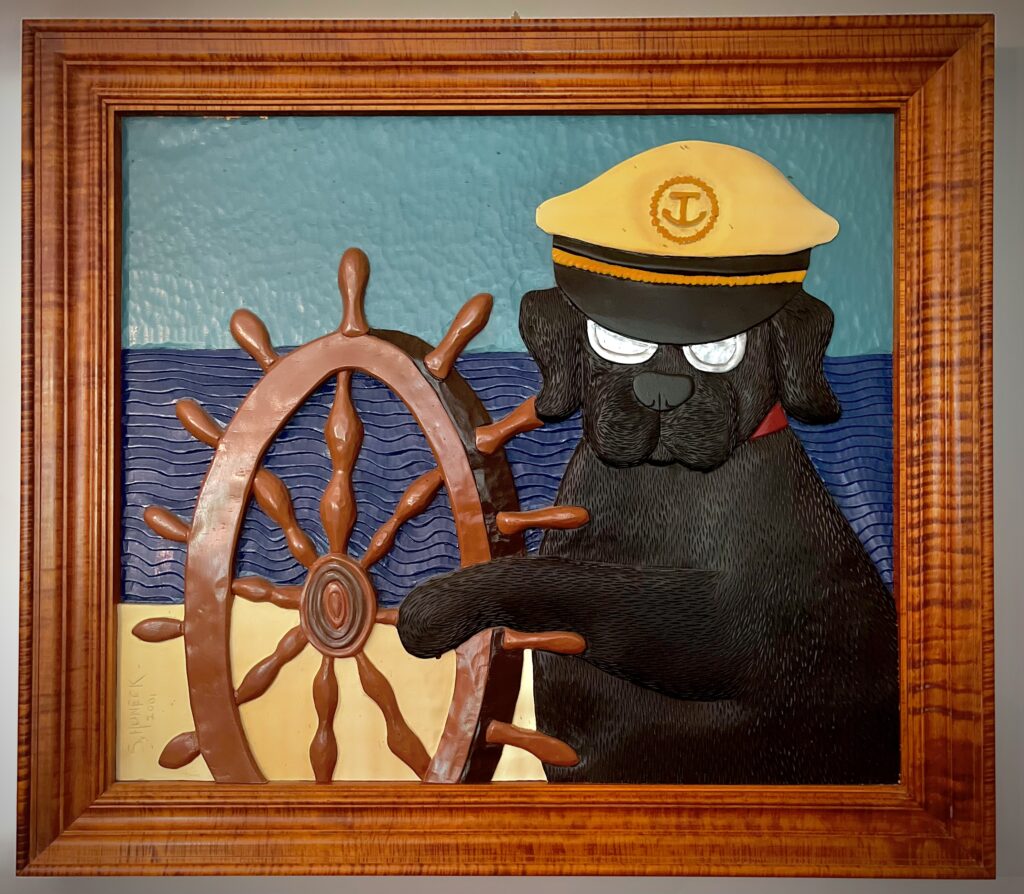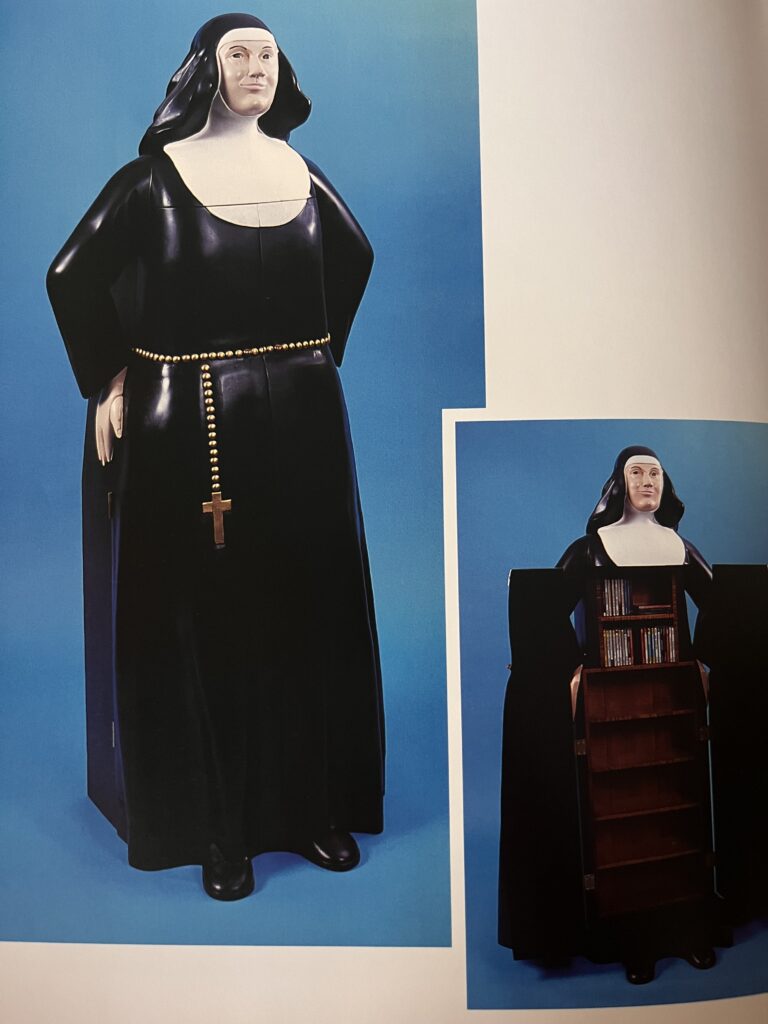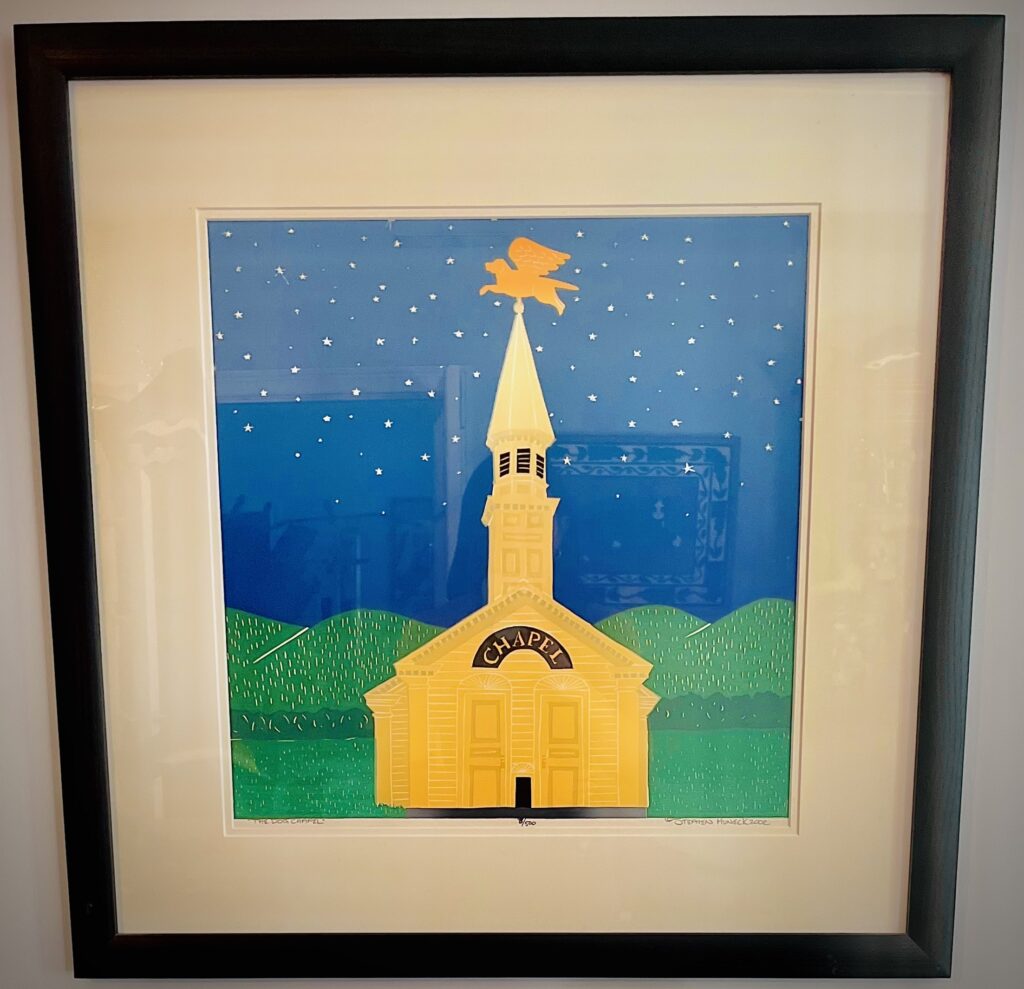BLOG
Finds and Interests
In our previous adventure, we embarked on a captivating exploration of my father’s remarkable collection of Stephen Huneck’s artwork. Among the treasures amassed, the sculptures are the most unique and perhaps more valuable. Each sculpture’s story provides a glimpse into how my father acquired and intricately connected these amazing pieces to his world. Prepare to be captivated as we delve into narratives behind and uncover the artistic evolution of these extraordinary sculptures.

Image Source: Sarah Seippel
Who Was Sally?
Sally the Labrador retriever was one of Huneck’s beloved confidants. After a brush with death, Huneck’s furry friends became his muse, and he crafted his first woodblock print, My Dog’s Brain. Huneck’s two-dimensional prints are famous among his pieces. He despised power tools, believing they negated the creative experience. Instead, Huneck opted for hand tools, allowing him to achieve the subtlety of texture that gave his works their ornate charm.
As Huneck explored his new muse, he created the Life is a Ball print. One print followed another, each carefully composed with minimal self-assured strokes and a witty message. Other popular dog-themed prints from this time found in my father’s collection include Networking, Good Boy, Bad Dog, and Social Security. Huneck’s means of creating these prints were both profoundly unique and personal. To complete his work, Huneck drew from traditional American motifs, symbolism, and colors. Additionally, he was a bit unconventional from other artists at the time because he used traditional printmaking techniques to create his sculptures rather than using a faster means of production.
Huneck and Sally shared a sacred bond. As his dogs inspired him, it was as if he created magic with every stroke. Huneck’s main muse was Sally; however, he continued to produce gorgeous sculptures inspired by other breeds, such as dachshunds, Jack Russell terriers, and Bernese mountain dogs. In contrast, these dogs were featured less prevalently in Huneck’s works than Sally. However, he centered a notable number of pieces around dachshunds, including furniture, table lamps, and sculptures.
It’s Elementary

Image Source: “Nun Cabinet.” The Art of Stephen Huneck by Laura Beach (2004).
Stephen Huneck claimed himself as an “unconventional learner,” and he quickly found solace in the realm of art. During his sophomore year in school, he enrolled in his first art course and embarked on creating his very first sculpture. Though he did not anticipate it to draw much attention, he received a positive response from his peers. Influenced by his unhappy memories from parochial school and his disdain for inauthentic authority figures, Huneck found inspiration in creating art that reflected his unique perspective on good and evil.
One of my father’s favorites from Huneck’s collection embodying this theme is the I Will Not Carve My Desk sculpture, meticulously crafted in 1995. Within this artwork, Huneck skillfully portrays a tiny devil, symbolizing a young Stephen, being pursued by an enormous statue of a nun brandishing a wooden stick. It is a thought-provoking representation, delving into Huneck’s journey and defiance against domineering forces.
Further treasures linked to this theme were Huneck’s Nun Cabinets and captivating blue Nun Chairs. Notably, Huneck told my father that he even sold a double nun cabinet, ingeniously repurposed as a liquor cabinet, to the late Sondra Locke—an intriguing twist that spices up the narrative behind the item. These pieces are less widely recognized than representatives of his overall artistic style and can be challenging to track down. Nevertheless, these artworks offer glimpses into the intricate world of Stephen Huneck’s perceptions and creative expression.
Huneck’s Bathing Beauties
Among the hidden treasures within Huneck’s body of work lies the Bathing Beauties series, which found its full development in Sally Goes to the Beach. These pieces, characterized by vibrant colors and curvy figures, pay homage to Huneck’s cherished memories of seaside pastimes. Within this theme, Huneck crafted various items, including lamps, woodcuts, CD cabinets, and sculptures, making them lesser-known gems sought after by collectors. Tracking down these pieces can prove challenging due to their limited production.

Image Source: Sarah Seippel
I found a delightful showcase of several elusive creations in my father’s specially curated room, known to me as the “Stephen Huneck room.” Among them, my personal favorite resides in the form of two Bathing Beauties floor lamps. As a child, I fondly recall imitating the sassy hands-on-hip pose of the carved women, seeking to elicit laughter from my family. Their whimsical nature captivated me; however, unbeknownst to me, these lamps were historically relevant works of Huneck.
The lamps may appear similar, but a notable difference lies in their appearance: one is vibrant with colors, while the other boasts a dark metallic finish. This contrast is due to Huneck’s experimentation with materials like resin and bronze for his sculptures. The metallic floor lamp in my father’s collection is one of the few, if not the only, pieces created by Huneck in China as he explored innovative ways to bring his artistic vision to life.
Welcome All Creeds, All Breeds, and No Dogmas Allowed

Image Source: Sarah Seippel
Huneck asserted that art was more than his hobby or career—it was his salvation and spirituality. Drawing inspiration from his beloved dog Sally, life experiences, and the world around him, Huneck sought to bring goodness into the world and express his profound spiritual connection with his canine companions. In 2000, he brought his vision to life by creating the Dog Chapel, an awe-inspiring architectural symbol featuring ornate stained glass windows, wooden pews supported by canine ushers, and sculptures of flying dogs and cats.
Beyond the art itself, the engaged public participation truly captured my attention. The chapel’s walls display letters and photographs from visitors who came to honor the memories of their cherished animal friends. This heartfelt response demonstrates that Huneck’s deep connection with animals resonated with countless others, proving that his art touched many lives beyond his own.
Happy Hunting!
Being an enthusiast of eclectic knick-knacks, I know that creating the perfect assortment requires time and patience. Stepping into my family’s home, with its museum-like ambiance, never fails to bring a smile to my face. The array of cookie jars, statues, and woodcut prints adds character to the joyous atmosphere created by my father’s unique collection. Ultimately, that’s precisely what Stephen Huneck stood for. While he undoubtedly sold his art as his career, his true legacy endures, and his work spreads joy to countless others. His work serves as a reminder of an animal companion’s unconditional love and evokes a similar sense of heartfelt connection. If fate grants you the fortune of encountering his work, I hope you discover the piece that resonates with your soul and warmly welcome it into your home.
Read about Will’s collection of Rookwood Pottery tiles around his home here.
Sarah Seippel is a freelance writer and finds much of her inspiration in her father’s unique collections. In her free time, she enjoys hunting down the best cup of coffee and pursuing for vintage deals.